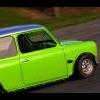Your thoughts are right, as borne out by Nightrain's (and my own) experience. An adjustable valve with no modification to the spring pressure can only be used to increase the rear braking effort.
ie, at minimum adjustment it will give the same pressure to teh rear brakes as a standard valve. The more you adjust it the higher the allowed line pressure and the easier the rear brakes will lock. To reduce the line pressure the spring must be swapped for a softer one or reduced in length slightly.
The common thought is that there were only two valves however when the anoraks go on it seems there were various ones. There is a post about this on one of the other forums but I'm struggling to find it at the moment.
A way round this is to use a rear cylinder size that gives the lowest possible rear brake effort then use the adjustable valve to increase the effort as required.
I thought the 1/2" cylinder gave the lowest braking effort on the rear rather than the 3/4" that GW suggests, but it is a long time since I investigated this so could well be wrong.
Several thoughts:
1) if you can't get ahold of a factory piece that fits your budget, there are some aftermarket ones available but they are not tailored to Mini pressure requirements. They do have a fairly wide range of adjustment, however.
2) the factory valve is a pressure limiting valve. Once the hydraulic pressure arriving from the master cylinder overcomes the valve's spring tension, the valve shuts and allows no greater pressure to be applied to the rear wheels. You would need a valve with a spring tension low enough that it shuts before your rear wheel cylinders receive the pressure that they are now receiving.
2) if you decide to modify the rear wheel cylinder size, you want to use a SMALLER diameter wheel cylinder in order to reduce the amount of braking force applied to that wheel.
Following is the text of an article that Keith Calver wrote some time ago that might provide some ideas.
UNDER PRESSURE
A veritable flurry of requests on the subject of rear wheel cylinders prompted this one. And I have to confess to having been a little remiss on this subject when I covered brakes in general way back in August/September/October 1997. Largely because I was tight for editorial space. Some things never change! (Eh-Ed?). So I thought I'd put things right.
The problems start occurring when folk graft alternative brake set-ups onto the front of their Minis. Be this 7.5" discs onto a previously drum-braked model, or going from current standard disc set-ups to one of the 4-pot varieties. The question is then 'what rear wheel cylinders do I need?' Unfortunately this isn't straightforward. Actually, that's not strictly true - but I'm saving the best for last! A quick re-cap on what controls brake effectiveness, aside from disc size, pad type, co-efficient of friction, etc. The pressure developed in the lines. Understanding this may assist in choosing which way you should go for your particular set-up.
The basic facts you need to remember with dealing with brake pressures is how they are affected by the components you use. The amount of hydraulic pressure produced at the pedal is INVERSLEY proportional to the master cylinder bore, and the pressure produced at the caliper or wheel cylinder is the opposite to that. So a smaller bore master cylinder will develop a HIGHER line pressure than a larger bore one at the 'working end', and conversely a smaller bore caliper piston or wheel cylinder will develop LOWER line pressure at the 'working end'. I know we're supposed to be looking at rear wheel cylinders here - but this is relatively important. Especially on racers where master cylinders and pedal assemblies may well be changed for something more, well, 'racy'. The former and following information, once ingested and understood, will help many folk find a path through the jungle. However, a large proportion of the questions I get asked are for road use, so we'll concentrate on the rear cylinders now.
Over the years, Austin Morris, BL, Leyland, and Rover have all had a dabble at messing with the braking systems components fitted to the Mini in its various forms. It could be said that this has left us in a fortunate position as far as choice goes as no less than five different wheel cylinder bore sizes were used. All of which will fit any brake back-plate with relative ease, i.e. may need to drill the locating pinhole on the other side. GWC1101 has a 0.625" bore, GWC1102 a 0.750" one, GWC1126 a 0.500" one, GWC1129 a 0.6875" one and GWC1131 a 0.5625" one. Quite a selection as stated, but confusion is added by the use of pressure regulators/distributors. Some of which don't do any regulating of the pressure at all. So which goes with what?
Alluded to earlier, this isn't clear-cut. There are too many variables including all-up car weight, tyre size and type, front brake choice, etc., to make an exact and correct list. As a guide to start with, working suggestions I have used with reasonable success can be generally channelled into a few groups. Discs with 4-pots and latest built-in servo and 7.5" discs with S-type servo, use GWC1131. 8.4" discs with or without servo, use GWC1102. 7.5" discs no servo use GWC1126. This is presupposing NO regulator valve is used on the rear subframe as they really complicate matters, and is irrespective of master cylinder bore size. I re-iterate - it's a working start. Incidentally - that thing on the bulkhead (called a P.D.W.A. - pressure differential warning activator) is there purely to maintain line pressure in one half of the system (be it front/rear or diagonal split) in case of failure in the other. It DOES NOT regulate the line pressure when braking with the system working normally as many believe. Some of the regulation is done in the master cylinder, the rest with the wheel cylinders.
What's this reasonably straightforward way mentioned earlier? Simple. I now always plumb in a Mini Spares Centre MS72 adjustable brake regulator between front and rear brakes and use GWC1102 rear wheel cylinders (cheapest of the bunch) if not already fitted. Sometimes under the bonnet by the master cylinder (easiest to fit and plumb in), sometimes by the driver's seat (usually race-orientated stuff). Not only does it facilitate fine-tuning of the rear brake efficiency, it's generally cheaper as the correctly sized rear wheel cylinders can be costly. Make sure you get a price before ordering!
Edited by mini7boy, 11 March 2009 - 06:51 AM.
















